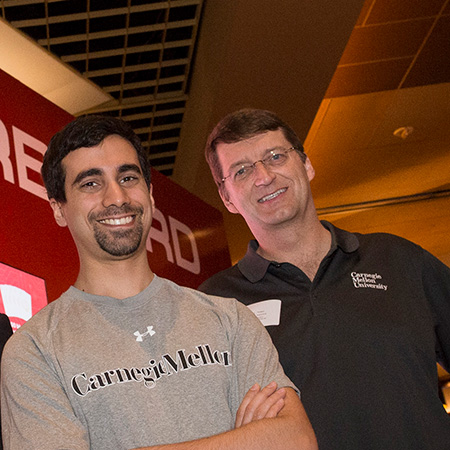
Carnegie Mellon “Baby Tartanian8” Pokerbot Sweeps Annual Competition
Original Tartanian8 Strategy Computed on SDSC’s ‘Comet’ Supercomputer
Published Date
By:
- Byron Spice
- Warren Froelich
Share This:
Article Content

Baby Tartanian8, created by Carnegie Mellon University’s Noam Brown and Tuomas Sandholm, not only took first place in the Annual Computer Poker Competition total bankroll category of the Heads-Up, No-Limit Texas Hold'em game, but also won the game's bankroll instant run-off category. The original Tartanian8 strategy was computed on SDSC’s ‘Comet’ Supercomputer. Source: Carnegie Mellon University
Contestants all knew Carnegie Mellon University’s (CMU) latest computer poker program, Baby Tartanian8, was good. As it turns out, its performance in the Annual Computer Poker Competition held earlier this year was even better than people thought.
Not only did Baby Tartanian8 take first place in the competition’s total bankroll category of the Heads-Up, No-Limit Texas Hold’em game, as announced in February at the Association for the Advancement of Artificial Intelligence meeting in Phoenix, but organizers recently concluded that it also won the game’s bankroll instant run-off category.
Baby Tartanian8, created by CMU Professor of Computer Science Tuomas Sandholm and Noam Brown, a Ph.D. student in the Computer Science Department, originally placed third in the bankroll instant run-off category. But it later emerged that an error occurred when additional matches were run to separate the four top-scoring pokerbots for Heads-Up, No-Limit Texas Hold’em. The additional matches erroneously used the same sequence of cards, which biased the results.
“Our ‘baby’ version of Tartanian8 was scaled down to fit within the competition’s 200 gigabyte data storage limit,” said Sandholm. “It also could not do sophisticated, real-time deliberation because of the competition’s processing limit. The original Tartanian8 strategy was computed in late fall by myself and Noam on the Comet supercomputer at the San Diego Supercomputer Center (SDSC).”
This is the second consecutive sweep of the game’s categories by a Carnegie Mellon pokerbot from Sandholm’s lab, based in Pittsburgh, PA. During the previous computer poker competition, in July 2014, the CMU team’s Tartanian7 won both categories in Heads-Up, No-Limit Texas Hold’em, prompting the CMU School of Computer Science to create a “Brains Vs. Artificial Intelligence” competition in the spring of 2015 that pitted Sandholm’s ‘Claudico’ pokerbot against four of the top 10 Heads-Up No-Limit Texas Hold’em professional players. That two-week, 80,000-hand contest at Pittsburgh’s Rivers Casino ended with three of the four pros with higher winnings than the pokerbot, but not quite enough to attain statistical significance.
Tartanian8 was a completely new bot whose strategy was created by algorithms from scratch. The algorithms were more advanced than those used to create Tartanian7 and Claudico.
Poker has become a major test of artificial intelligence (AI), Sandholm explained, because it is an incomplete information game. Players don’t know what cards their opponents hold and all players try to mislead their opponents by bluffing, slow play, and other devices.
The same sort of algorithms used to play poker could also be used to create strategies for applications involving cybersecurity, business transactions, and medicine – all application that Sandholm’s research group works on. For instance, an AI might help doctors develop sequential treatment plans for a patient, or design drugs that are less prone to resistance. Or, such an AI might help people negotiate their best deal when purchasing a house or a car.
Share This:
You May Also Like
Stay in the Know
Keep up with all the latest from UC San Diego. Subscribe to the newsletter today.


